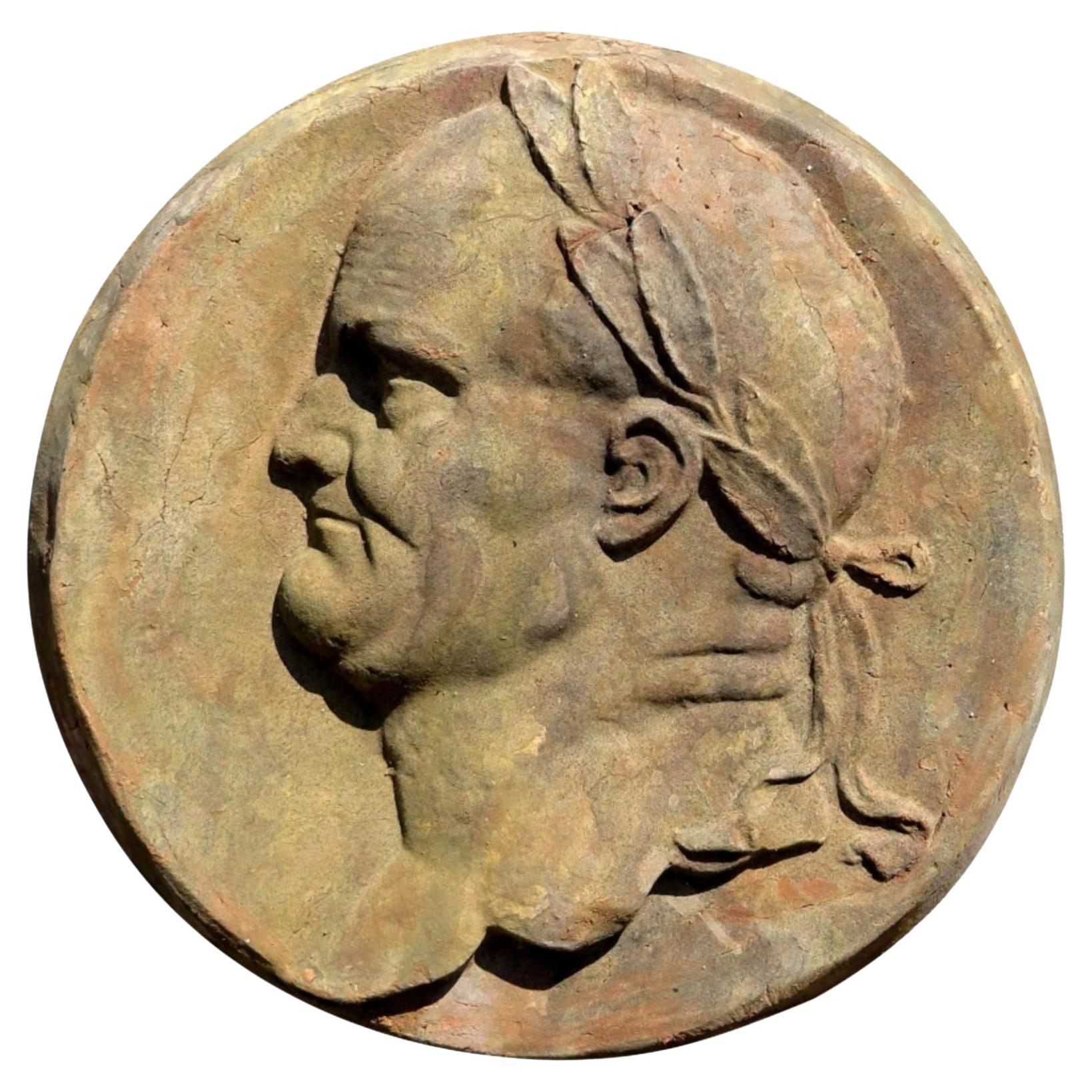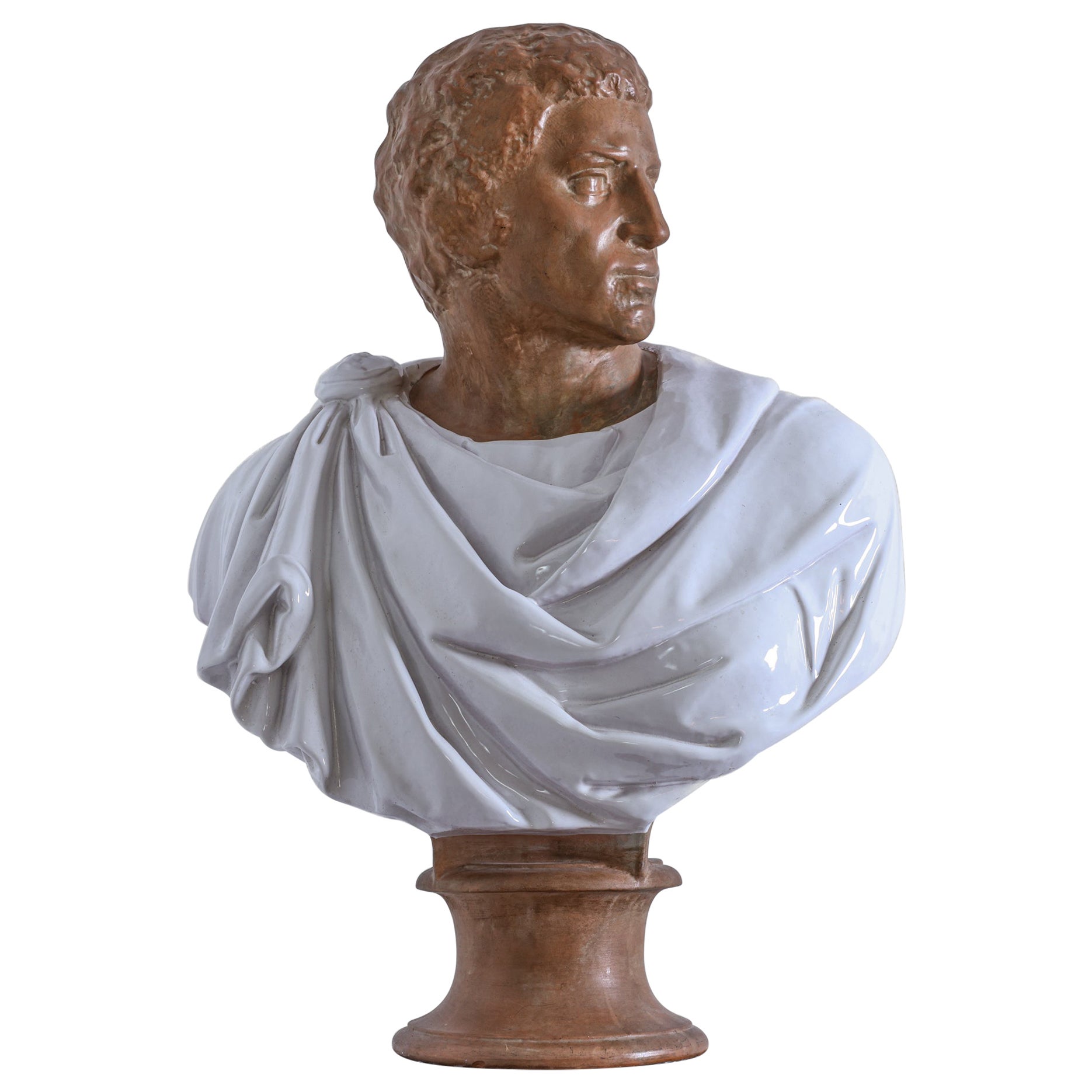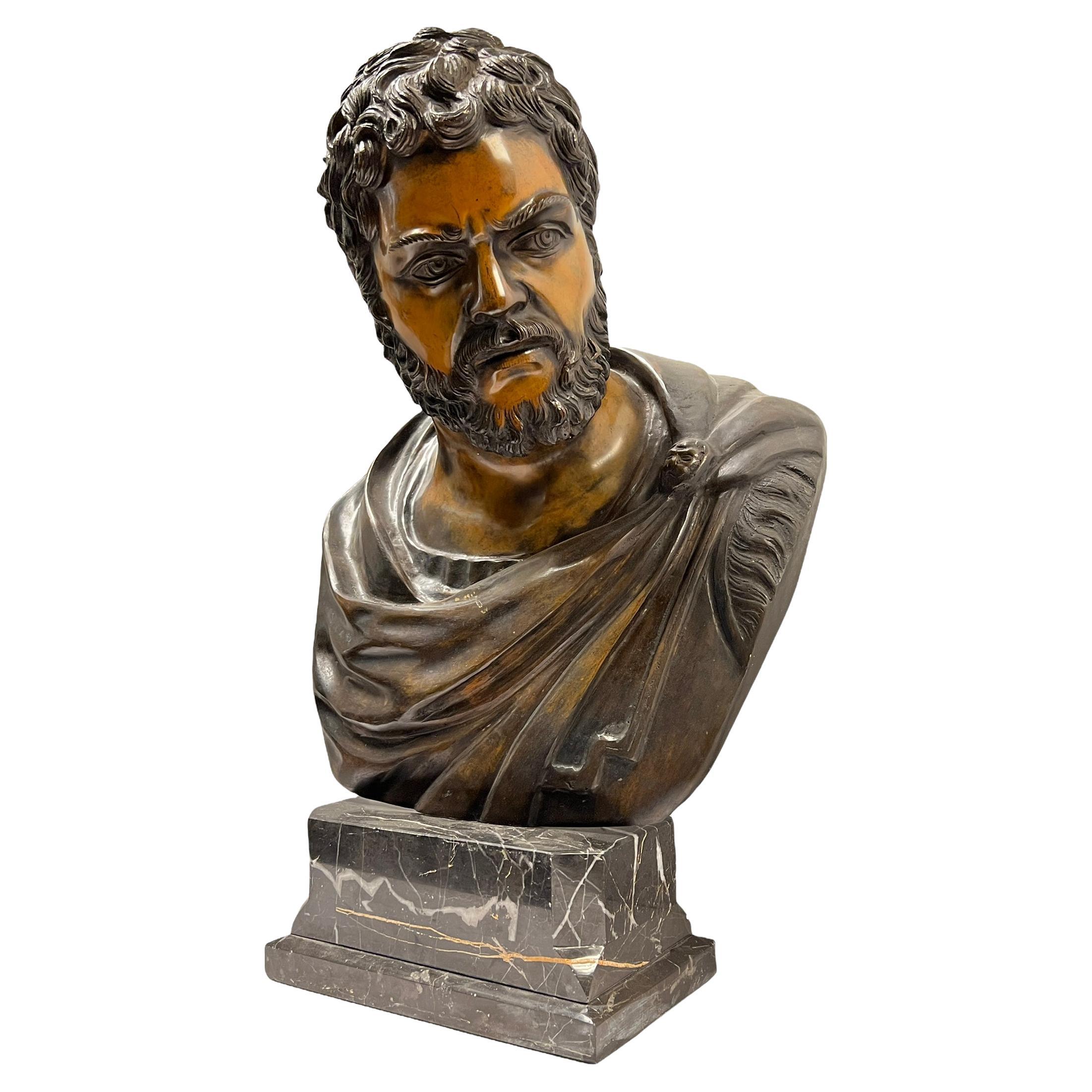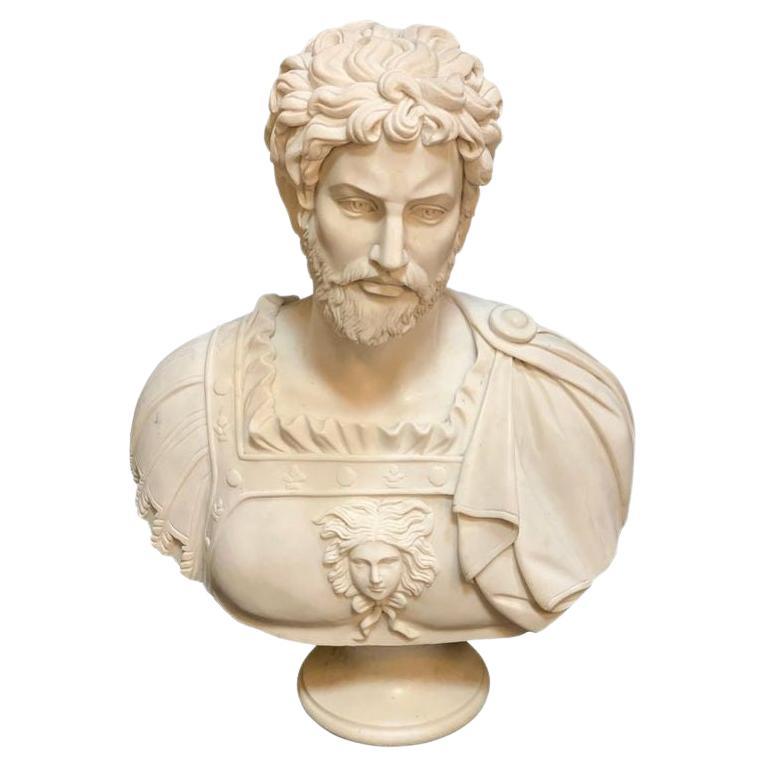Items Similar to 18th-19th Century Neoclassical Multi-Marble Bust of Roman Emperor Titus Domitian
Want more images or videos?
Request additional images or videos from the seller
1 of 21
18th-19th Century Neoclassical Multi-Marble Bust of Roman Emperor Titus Domitian
About the Item
A striking late 18th-early 19th century bust of the Roman Emperor Titus Domitian. The head is made from hand carved white Carrara marble, the tunic and toga are made from hand carved honey alabaster, which are all supported on a cipollino marble socle. The bust rests on a robust column of red Breccia Pernice marble, mounted on a Carrara marble base and top.
The detail to this bust is truly exceptional. The quality of a marble bust is noted from a few factors; the first being the hair of the bust. Hair is an extremely delicate and free-flowing body part, which makes it very difficult to hand-carve with a realistic feel. The next factor in marble bust quality is demonstrated in the face. Humans have distinct characteristics that sets them apart from one another. An exceptional bust allows someone to just glance upon it and recognize the person immediately. The final factor in marble bust quality is the clothes. Like hair, fabrics are free-flowing in nature, with variable curves and inconsistencies. A true master marble sculptor will exceptionally carve the general attire of the bust, in this case a tunic and toga, to resemble that of a free-flowing garment in the breeze, with curves and silhouettes. This bust of the Roman Emperor Titus Domitian reflects all these key characteristics and more. The hair is elegantly hand carved with exceptional detail, seemingly life-like in appearance. The facial features are perfectly in line with what Emperor Titus Domitian's is regarded to look like, a strong Romanesco nose, lightly wrinkled forehead, frowning eyebrows, a mid-sized mouth, and well-carved ears with a slight left head tilt. Finally, the garments on this bust, which include the tunic and toga, are exceptionally well hand carved, demonstrating natural free-flowing linen silhouettes, curves and billows. The culmination of these key-characteristics define this marble bust as truly exceptional.
Titus Flavius Caesar Domitianus Augustus was Roman emperor from 81 to 96 AD. He was the younger brother of Titus and the son of Vespasian, his two predecessors on the throne, and the last member of the Flavian dynasty. Domitian had a minor and largely ceremonial role during the reigns of his father and brother. After the death of his brother, Domitian was declared emperor by the Praetorian Guard. His 15-year reign was the longest since that of Tiberius. As emperor, Domitian strengthened the economy by revaluing the Roman coinage, expanded the border defenses of the Empire, and initiated a massive building program to restore the damaged city of Rome.
- Dimensions:Height: 68 in (172.72 cm)Width: 24 in (60.96 cm)Depth: 12 in (30.48 cm)
- Style:Classical Roman (In the Style Of)
- Materials and Techniques:
- Place of Origin:
- Period:
- Date of Manufacture:1790-1800
- Condition:Wear consistent with age and use. Minor losses.
- Seller Location:New York, NY
- Reference Number:1stDibs: LU919516041222
About the Seller
4.9
Platinum Seller
These expertly vetted sellers are 1stDibs' most experienced sellers and are rated highest by our customers.
Established in 1820
1stDibs seller since 2011
136 sales on 1stDibs
Typical response time: 1 hour
- ShippingRetrieving quote...Ships From: New York, NY
- Return PolicyA return for this item may be initiated within 1 day of delivery.
More From This SellerView All
- 19th Century Italian Ormolu Mounted Multi-Marble Julius Caesar Coliseum ModelLocated in New York, NYA 19th Century Italian Ormolu Mounted Multi-Marble Julius Caesar Coliseum Model. This is a beautiful rendition of a Roman coliseum with a dore bronze mounted Julius Caesar standing in the middle of the marble masterpiece. The domed top is made up of multiple marble species including verde marble, carrara marble, and rough marble...Category
Antique 1860s Italian Classical Roman Figurative Sculptures
MaterialsMarble, Carrara Marble, Siena Marble, Bronze
- Set of 4 19th C. French Patinated Bronze Marble Mounted Busts of PhilosophersLocated in New York, NYA Set of Four 19th Century French Patinated Bronze Marble Mounted Busts of Philosophers. The stunning patina adorning each bust accentuates the intricate facial expressions, breath...Category
Antique 19th Century French Louis XVI Busts
MaterialsMarble, Bronze
- Antique Italian Neoclassical Carrara Marble Bust of Daphne, Apollo's First LoveLocated in New York, NYA fabulously hand carved antique neoclassical style Italian Carrara marble bust of Daphne. This bust is of immaculate quality and craftsmanship. Daphne's hair is beautifully hand car...Category
Antique Mid-19th Century Italian Neoclassical Busts
MaterialsCarrara Marble
- Pair of 18th Century Meissen Porcelain Figurines of the SenseLocated in New York, NYA fine pair of 18th century Meissen Porcelain allegorical figurines of smell and hearing from a set of the senses probably modeled by J....Category
Antique 18th Century and Earlier German Rococo Sculptures
MaterialsPorcelain
- An Italian 19th C. Marble Sculpture of "Flora's Embrace", By Professore F. GalliBy Fortunato GalliLocated in New York, NYA Monumental Italian 19th Century Marble Sculpture of "Flora's Embrace", By Professore F. Galli. Flora's Embrace, an exquisite marble sculpture by the esteemed Professore Fortunato G...Category
Antique 1890s Italian Belle Époque Figurative Sculptures
MaterialsCarrara Marble
- A Pair of Early 19th Century Meissen Porcelain Figures of SwansLocated in New York, NYA Pair of Early 19th Century Meissen Porcelain Figures of Swans. This pair of swans portrays the graceful form of these birds with a level of artistry that is truly exceptional. The...Category
Antique 1840s German Rococo Revival Animal Sculptures
MaterialsPorcelain
You May Also Like
- Titus Roman Emperor, Terracotta Round End, 19th CenturyBy Europa AntiquesLocated in Madrid, ESTitus Roman Emperor, terracotta round end 19th century. Diameter 31cm. thickness 6cm. weigh 8kg. Material terracotta. Very good condition. Titus Flavius Caesar Vespasian Augustus (in Latin: Titus Flavius Caesar Vespasianus Augustus; in the epigraphs: IMP•T•CAESAR•VESPASIANUS•AVG•PON•M•TR•POT[1]; Rome, 30 December 39 – Aquae Cutiliae, 13 September 81, better known simply as Titus, was a Roman emperor, belonging to the Flavian dynasty, and reigned for just over two years from 79 to 81, the year of his death. Before ascending the throne, Titus was an able and esteemed general who distinguished himself for the repression of the rebellion in Judea in 70, during which the second temple in Jerusalem was destroyed. He was considered a good emperor by Tacitus and other contemporary historians; he is known for his program of public works in Rome and for his generosity in rescuing the population following two disastrous events: the eruption of Vesuvius in 79 and the fire in Rome in 80. Famous is the definition that the historian Suetonius gave of him: "Amor ac deliciae generis humani. » « Love and delight of mankind. » Titus' family, the gens Flavia, belonged to that Italian nobility which, in the first half of the first century, was gradually replacing the more ancient Roman aristocracy, weakened by the decades of civil wars fought in the first century BC. The Flavians, in fact, were not of noble origins, but they managed, within just three generations, to rise from humble origins to the honor of the imperial purple. Tito's paternal great-grandfather, Tito Flavio Petrone from Rieti, had fought as a centurion evocatus in the army of Gnaeus Pompey the Great during the civil war of 49-45 BC, fighting in the battle of Farsalo and fleeing after the defeat of the Pompeians; he was pardoned by Cesare and became tax collector...Category
Antique Late 19th Century Italian Baroque Figurative Sculptures
MaterialsTerracotta
- 19th Century Young Emperor BustLocated in Roma, IT19th century bronze bust of young emperor. This object is shipped from Italy. Under existing legislation, any object in Italy created over 70 years ago by an artist who has died re...Category
Antique 19th Century Italian Classical Roman Busts
MaterialsBronze
- Italian Early 19th Century White Carrara Marble Bust of a Roman EmperorLocated in West Palm Beach, FLA handsome and high quality Italian early 19th century white Carrara marble bust of a Roman Emperor. The bust is raised by a circular Bleu Turquin marble base with a decorative mottl...Category
Antique 19th Century Italian Busts
MaterialsCarrara Marble
- Terracotta Bust of Roman EmperorLocated in Palm Desert, CAThis terra-cotta sculpture no doubt depicts the bust of Roman Emperor or Senator in classical dress gazing over his left shoulder. This is a magnificently robust life size bust...Category
Vintage 1960s Italian Classical Roman Busts
MaterialsTerracotta
- Bronze Bust of Roman EmperorLocated in New York, NYlarge and impressive mid century Italian Bronze Bust of Roman Emperor on a marble base.Category
Mid-20th Century Italian Classical Roman Busts
MaterialsMarble, Bronze
- Late 19th Century Italian Marble Bust of an EmperorLocated in Los Angeles, CAGraceful bust sculpture made of rich carrara white marble, finely depicting a Roman emperor. Made in Italy in the late 19th Century. Dimensions: 31"H x 23"W x 14"DCategory
Antique Late 19th Century Italian Other Busts
MaterialsCarrara Marble
Recently Viewed
View AllMore Ways To Browse
Antique Greek Or Roman Marble Bust
Greek Or Roman Bust
Roman Marble
18th Century Roman Furniture
Carved Earings
Marble Sculptures Roman
Roman Marble Sculpture
Hand Carved Roman
Roman Hand Sculpture
Roman Heads Furniture
Emperor Sculpture
Neoclassical Marble Sculpture
Emperor Set
Roman Sculpture Two
Marble Socle
18th Century Marble Sculpture
Roman Ad
Hand Carved Emperor





